This post may contain affiliate links. Please read our disclosure policy.
These almond flour tortillas are made with a blend of almond flour and coconut flour, and the dough is so easy to handle. We also add a touch of xanthan gum to help keep them pliable, and they'll bend and fold any way you like. Add your favorite fillings and wrap them up like a burrito that won't break!
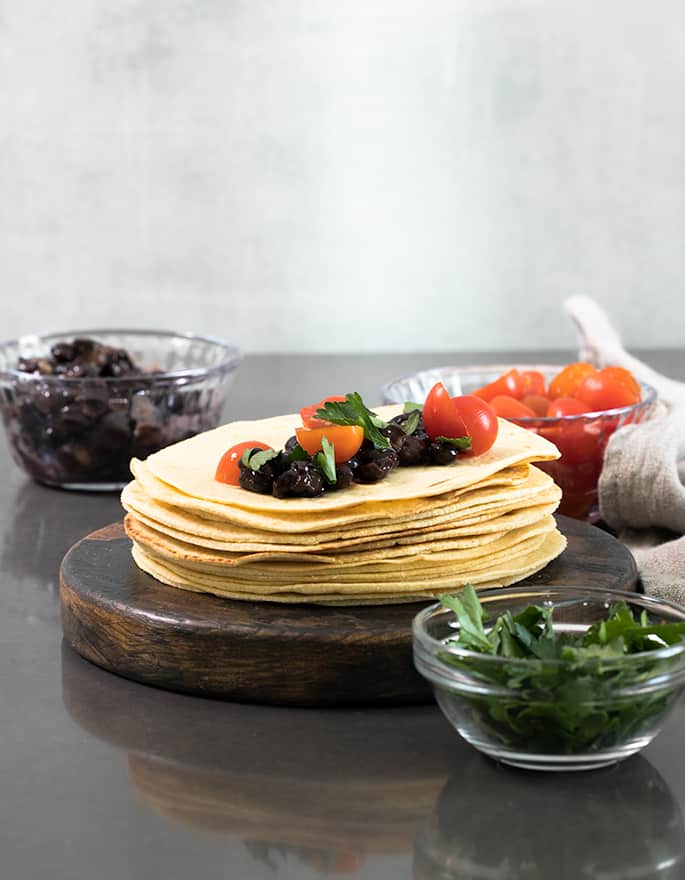
Why you'll love these tortillas
Almond flour is kind of a magic baking ingredient. It's not cheap, though, so it's nice if you can extend both its reach and its versatility by combining it with another flour.
In the past, I've reached for tapioca starch/flour as a match for it as I did in these soft Paleo flour tortillas, in my beloved coconut flour pancakes which are so good and amazingly so fluffy, and in my almond flour muffins. It really is one of my absolute favorite baking ingredients.
Tapioca starch as it's one of the most versatile gluten free baking ingredients of all. But it's, well, a starch (even though it's sometimes referred to as tapioca flour). It's a really stretchy, useful starch, and doesn't have a true equal so there is no reliable substitute for it. Using it in this recipe makes these tortillas just as flexible and sturdy as a classic gluten free flour tortilla.

What purpose does coconut flour serve in these almond flour tortillas?
For these low carb tortillas, I chose to pair coconut flour with almond flour. It's not only less expensive, it's also very low in carbohydrates and high in fiber. I really do love baking with almond flour, as it's high in good fats and low in carbs, but I only like baking with coconut flour.
Coconut flour tends to require the addition of many, many eggs as it absorbs so much moisture. There is a tipping point, though, where whatever you're baking can just taste like an omelet if you're not careful. Instead, I've been experimenting with replacing some of that moisture with, well, water.
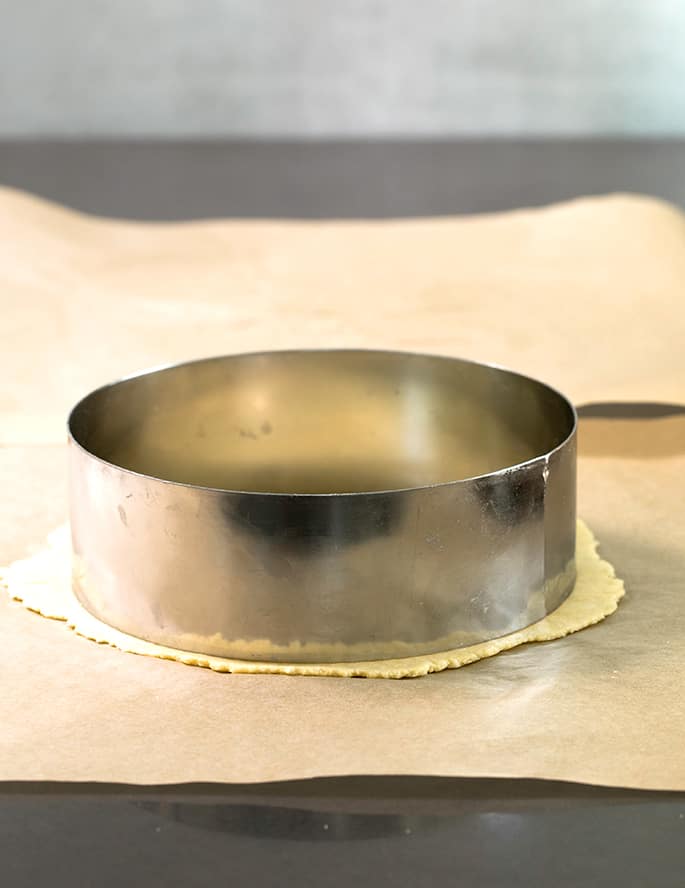
Shaping the tortillas
Before you begin working with this dough, please read through all the instructions in the recipe card below. The instructions are pretty specific, but that's only to help you understand what to expect.
If you mess up and find that the dough is just too wet to roll out properly, add more coconut flour by the pinch (literally—1/8 teaspoon) and knead it into the dough, then try again. Generally, it's easier to add moisture than to take it away, so go slowly when adding water to the food processor.
Some readers have reported successfully using a tortilla press to shape the dough into rounds. I find that they don't get thin enough that way, but it can give you a start. Just be sure to line the press with sheets of parchment paper.

FAQs
Yes! These almond flour tortillas only have 2 net carbs in each tortilla.
Yes! This dough is actually very durable and therefore easy to handle. You'll be amazed by how thin you can roll the dough and still move it from the rolling surface to a hot griddle.
No, Mission brand u0022Carb Balanceu0022 wraps are not gluten free! Some of the marketing for those low carb wraps refers to them as u0022keto friendly,u0022 but the second and third ingredients are wheat starch and wheat flour, and the package states that it u0022contains wheat.u0022 Wheat is a gluten-containing grain and must be avoided on a gluten free diet.
They don't contain any grains, dairy, or refined sugars, so they should be considered Paleo, yes.
You do really need the xanthan gum in this recipe. Without it, though dough is very crumbly and you just won't be able to roll it out and have it hold together long enough to even get it on the griddle.
Guar gum should work in its place if you prefer that. I do have a recipe for Paleo tortillas made without xanthan gum (that isn't nearly as low carb) that you might prefer if xanthan gum is a problem. If you'd like to experiment and don't mind the taste, try using 8 grams of finely ground psyllium husks to the dry ingredients in place of 4 grams of xanthan gum before adding the warm water.
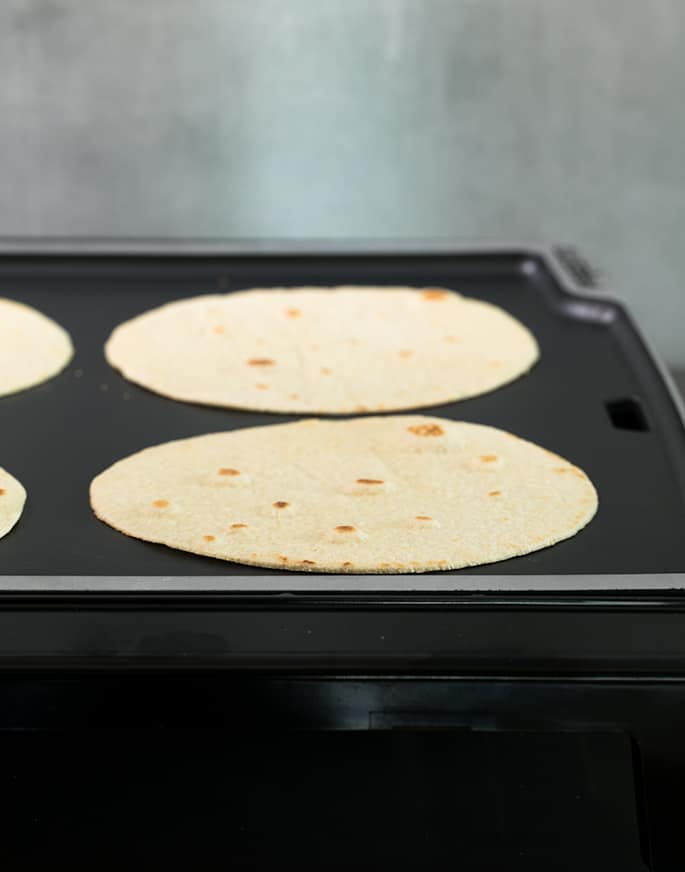
Recommended equipment
If you're curious about the baking equipment that I used, in the photo above you'll find the Presto 15″ Tilt-n-Fold Griddle (that's an affiliate link, but please feel free to shop around). I absolutely love this griddle for its size and the shape, and use it for everything I can these days. It's so easy to store, heats very evenly and was really reasonably priced. You can always use a stick pan like a cast iron skillet, too.
I used a 6-inch cake cutter (affiliate link) (scroll up for that photo) to get neat edges on the tortillas. It's a very useful little trinket to have in the kitchen, but it's totally not necessary at all. The lid of a pot works great for the same purpose, or rough edges left intact are of course perfectly fine!

Ingredient substitutions
These tortillas are already dairy free, but there are other potential allergens in the ingredients that we can discuss replacing.
About baking with almond flour
This recipe calls for finely ground blanched almond flour, which is really the only sort of almond flour I use for baking. You can't use almond meal, which is a much more coarse grind and is made using almonds that still have their skins.
If you'd like to replace the almond flour entirely, you should be able to use finely ground cashew flour without any issue. To make this recipe nut-free, you can try sunflower seed flour, but the tortillas may turn green. ? The chlorophyll in the sunflower seeds reacts with baking powder, leading to a green color, but it's harmless. Maybe perfect for St. Patrick's Day?!
About using coconut flour
Generally, there is absolutely no substitute for coconut flour on a 1:1 basis. It's entirely unique, filled with fiber and absorbs a ton of moisture.
But I tested this recipe with 6 tablespoons (48 g) of tapioca starch/flour in place of the coconut flour, and it still worked! The dough isn't quite as resilient when handling, and the tortillas tend not to bend as well. I found that they were better the next day when stored in a sealed plastic zip-top bag along with a moistened paper towel. They will definitely have more carbs, though
Can you make these almond flour tortillas without an egg?
I haven't tested this recipe with an egg substitute, but my favorite “chia egg” (1 tablespoon ground chia seeds + 1 tablespoon lukewarm water, mixed and allowed to gel) should work since it's only one egg in the recipe.
About the baking powder in these almond flour tortillas
Baking powder is a mix of starch, baking soda, and cream of tartar. Conventional baking powders are typically made using cornstarch, which is not appropriate for a Paleo diet.
If you'd like to make these low carb tortillas Paleo-friendly, just use a Paleo baking powder, made with a starch like tapioca or arrowroot.
P.S. If you're following Weight Watchers, each tortilla has 3 SmartPoints and is really satisfying!
Almond Flour Tortillas Recipe
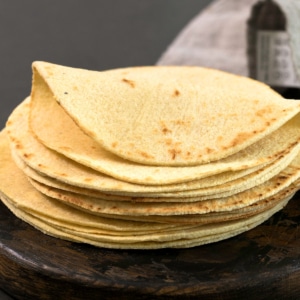
Equipment
- Food processor fitted with steel blade a miniature food processor is fine
Ingredients
- 13 tablespoons (98 g) finely ground blanched almond flour
- ¼ cup (28 g) coconut flour
- 1 teaspoon (4 g) xanthan gum
- 1 teaspoon baking powder
- ½ teaspoon kosher salt
- 1 (50 g (weighed out of shell)) egg, at room temperature, lightly beaten
- 2 tablespoons (1 fluid ounce) lukewarm water, plus more as necessary
Instructions
Prepare the dough.
- In a food processor (a miniature one will do), place the almond flour, coconut flour, xanthan gum, baking powder, salt, egg and 2 tablespoons of water, and pulse to combine.
- If the dough holds together well and feels moist but not wet, process until it forms a ball and mostly clears the dough from the bottom of the container.
- If the dough feels at all dry, add more water by the teaspoonful, processing after each addition until it reaches the proper consistency. Continue to process until the dough forms a ball as directed.
Let the dough rest.
- Transfer the dough from the food processor to a piece of plastic wrap, wrap tightly and store in the refrigerator until you’re ready to make the tortillas (up to 4 days). It’s best to allow the dough to chill for at least 10 minutes.
Shape and cook the tortillas.
- When you’re ready to make the tortillas, heat a nonstick or cast iron griddle until hot (if using an electric griddle with a temperature gauge, heat it to 375°F).
- Unwrap the dough and divide it into 8 pieces of equal size. Working with one piece of dough at a time, roll it into a ball between your palms and then press it into a disk.
- Place on a large piece of unbleached parchment paper and top with another large piece of parchment paper. Use a rolling pin to roll the dough into a round about 7-inches in diameter.
- For best results, periodically remove the parchment paper from either side, flipping it frequently to prevent the paper from sticking or wrinkling too much.
- Carefully remove the top piece of parchment by pulling it away from the dough slowly and cut out a 6-inch round using a 6-inch cake cutter or the lid of a pot. Remove the excess dough and replace the top parchment.
- Flip the dough over and carefully pull the paper away from the dough. It should now be rather easy to lift the dough from the papers entirely.
- Place the shaped, raw tortilla on the hot griddle and allow to cook, flipping frequently and pressing down with a wide spatula, until it’s opaque on both sides and the tortilla has developed a bit of color.
- Repeat with the remaining dough, stacking the warm tortillas on top of one another.
How to store the tortillas.
- Serve immediately, or place a stack in a zip-top plastic bag. Place a moistened paper towel into the bag before sealing it tightly. This will help keep the tortillas moist until you are ready to serve them.
- They can be refreshed in a hot, dry skillet before serving if desired.
Video
Notes
Nutrition
Nutrition information is automatically calculated, so should only be used as an approximation.


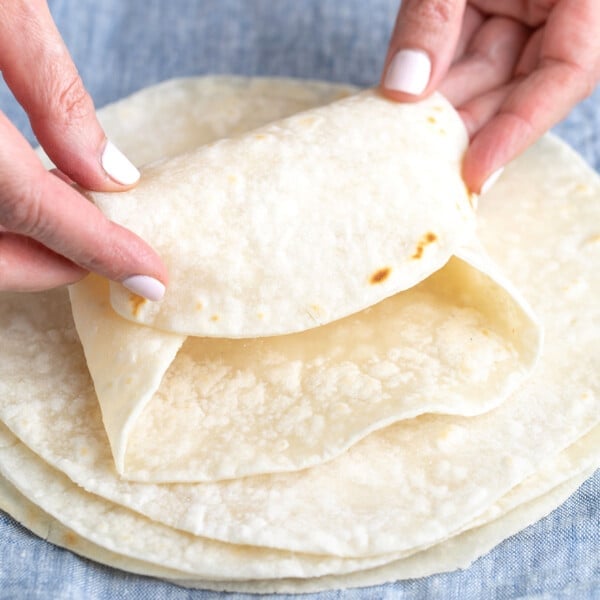
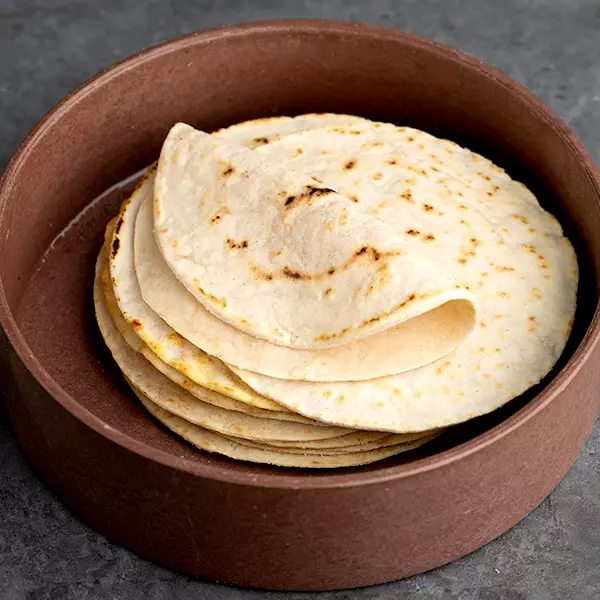
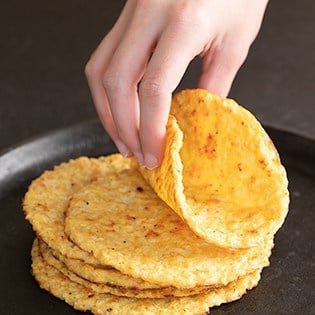
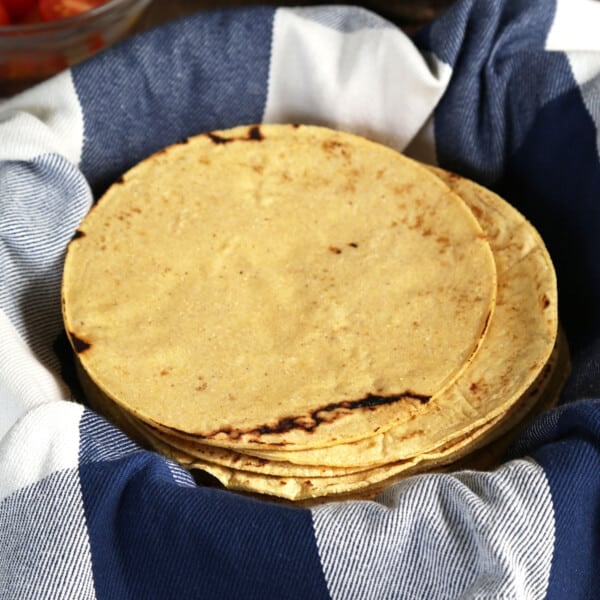









I would like to subsitute millet flour instead of almond flour. Think that would work out?
That wouldn’t, no, Theresa. They are completely different. Please see the section on ingredients and substitutions for suggestions on what might work instead, but I’d really recommend you make the recipe as written!
These tortillas turned out fabulous.
We used them for fish tacos. Tks for perfecting your recipe Nicole & sharing it with us ?
Thanks for letting me know, Munira! So glad you enjoyed them. Wish I had a fish taco ??right now!
Would you be able to post a clear picture of the Nutrition Facts? It’s very small and even when I printed it off I can’t see the information. Thank you :)
Yes, I will upload another, slightly larger version if I can, Kim! Sorry about that. Stay tuned.
ETA: I uploaded what I think is a clearer image that you should be able to read now, Kim. Unfortunately, I can’t just make it a click-to-enlarge thumbnail photo easily. Hope this helps!
How did you know I was longing for tortillas that are not corn tortillas?? :)
We’re very connected, you and I, Elisa. ?
I followed the instructions to the letter. I got four very thin tortillas, not eight.
Hi, Meredith,
I have made this recipe at least 6 times and always got 8 tortillas. If you cut them larger than I did, and didn’t cut the edges off and reroll scraps, that could easily make fewer. Sorry I don’t have any more ideas!
How would it come out without the coconut flour? The reason is I have almond flour and I have g.f. baking and pancake flour(with x-gum in it)
I did read all your instructions, but I really didn’t want another flour.
Sorry to bug you! Thanks
Hi, Joan, I’m afraid you can’t make those sort of substitutions in a recipe like this. Beyond the ingredient and substitution information I’ve already provided, I’m afraid you can’t make other substitutions using the ingredients you have and have this recipe turn out. I recommend that you have a look at my gluten free flour blend page and decide upon an all purpose gluten free flour blend, rather than a pancake flour, which is much more limited.
Will it affect the outcome if one doesn’t weigh the egg out of the shell? I have never heard of that before but I’m excited to try your recipe. GF store bought ones are yucky. Thank you
Hi, Cheryl! Generally, no, it won’t affect the outcome. Rather than saying a “large” egg, I always refer to eggs by weight, as measured out of the shell, to accommodate readers who are using nonstandard eggs (maybe from backyard chickens). It also helps readers who are using extra-large eggs because they can beat and weigh the eggs and measure out only what the recipe calls for. If you have large eggs, they average about 50 grams, when weighed out of the shell. I hope that helps!
Is there any possibilty this could work with a hand mixer and dough hooks/regular blender attachment? I don’t have a food processor.
Hi, Jarah,
I’m afraid a mixer won’t work, but do you have any sort of blender at all (not necessarily a high-speed blender)? I’d recommend trying that. Hope that helps!